Kennemer Golf & Country Club
Zandvoort, Netherlands

Kennemer’s famous thatched-roof clubhouse presides over rumpled land ideally suited for golf.
During the Golden Age in golf course architecture, many of the same master architects that worked in the United Kingdom came across the English Channel to Continental Europe. Two in particular were Tom Simpson and Harry Colt. They divided Paris rather equally but further north, Colt’s work dominates in the Netherlands while Simpson’s does in Belgium.
Of the ten courses built by the firm of Colt, Alison & Morrison in the Netherlands, eight still exist to this day. In many ways, his work here is better preserved than in the United Kingdom, making a tour of his Dutch courses a must for any student of architecture. The fact that his work has been well looked after here is particularly surprising, given the horrors of World War II and the German occupation of the Netherlands.
Take Kennemer for example as it was Colt’s first project in the Netherlands. At one point, there were a staggering 122 German bunkers on its property as well as anti-tank walls. After the defeat of the Germans, the course was slowly nursed back to life. The club covered over many of the German bunkers by dunes and today’s course is a pure golf landscape with no hint of the grim times of the 1940s.Several of the bunkers remain in use today, one asthe maintenance facility andthree as shelters around the course.
Crucial to the re-birth of Kennemer in the 1950s was the club’s archives of Colt letters, hole descriptions and diagrams.Itis morecompletethan any such collection at anyColt club with which the author is familiar. To this day, the club shrewdly uses its archives to guide future decisions.
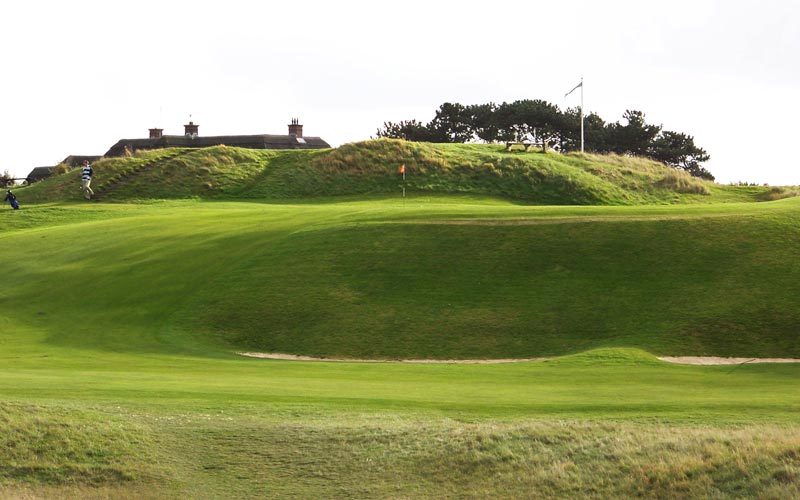
In Colt’s April 1926 letter to the club, he wrote in regards to the fifteenth, ‘This will be a most spectacular one shot hole’ and that it ‘should ultimately prove to be one of the best one shot holes ever made.
At Kennemer, Colt faced a challenge of working with one piece of property of two different types – dunes and field. The course starts from the high point of the property in front of the noble yet comfortable thatch-roofed club house in the dunes and tumbles away. The third hole makes the transition within the hole from dunes to field, and the next three holes are all in the field, near the rialway line at the edge of the property. Colt then brings the golfer back into the dunes, before he re-enters the field at the eleventh and twelfth, where, interestingly enough, the transition is made from right to left (rather than from the standard tee to green). The right side of the eleventh and twelfth holes features the edge of the dunes, while the left side belongs with the field holes. The golfer then returns to the dunes for good for the run home from the fifteenth. As with both Friar’s Head and Bandon Trails, and unlike, say, Spyglass Hill, the golfer knows that when he leaves the dunes he will return – a reassuring thought that does not lead to despair while playing the less dramatic, but still good, holes along the railway.
One little known fact is that Colt actually routed all twenty-seven holes at Kennemer. His 1937 routing for the third nine proudly hangs in the clubhouse foyer. This nine wasn’t actually built until 1985 by Dutch-born Frank Pennink, who adhered to Colt’s routing with one exception. Interestingly enough, his one deviation is the most controversial hole on the property, that being the sixth. Colt had it as a dogleg to the left but Pennink built it as a dogleg right, in part by making a ‘v’ cut into the dunescape that the author believes Colt would have been unwilling to do. As such, the hole makes for an interesting study in design techniques and how the evolution of golf course architecture was affected by earth moving equipment.
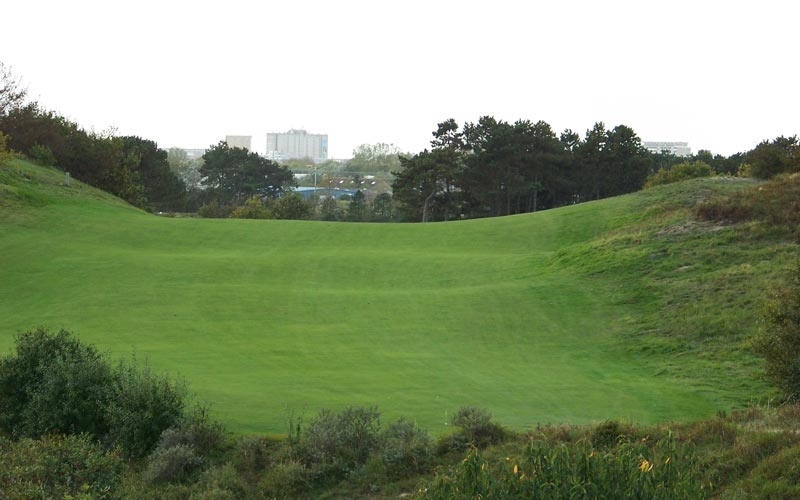
Pennink created this saddle in the ridge line off the sixth tee. The hole doglegs right at the base of the hill. Colt routed the tee shot at a ninety degree angle to the right of Pennink’s above and then had the sixth dogleg left.
The three nines at Kennemer are referred to as the A nine that Pennink built and the B and C nines that Colt built. In recent years, the Dutch Open has used an amalgamation of holes from each nine. Pennink’s A holes at 3,555 yards are the longest of the three nines, which is no surprise since it was built fifty-seven years later than Colt’s two nines. The A nine is used in its entirety as the front nine for the Dutch Open. The professionals then play the first three holes from the B nine followed by the last six holes of the C nine. This makes for a wonderfully diverse test but the great shame is that the seventh and ninth holes from the B nine don’t receive the attention that they deserve, as we see below.

The great ninth, sadly, is not used in the Dutch Open.
With a tip of the hat to Colt, the Holes to Note section details Colt’s B and C nines first, followed by the A nine that Pennink built.
Holes to Note
First hole, 450 yards; First, there was colf and colfers as early as the thirteenth century, followed by Kolven in the fifteenth century. Paintings dating that far back provide the evidence that the Dutch have played a ball and stick game for centuries. Aware of the strong Dutch ties to the roots of the game and combined with the gazes from the knowledgeable members in the nearby thatched roof clubhouse, the golfer needs to summons courage to make a bold positive swing.
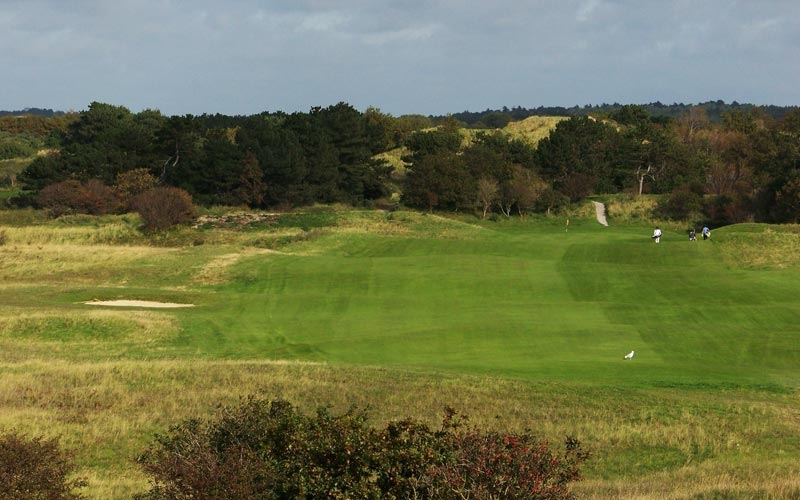
The first hole falls downhill away from the clubhouse to a most attractively placed green in its own dell.
Second hole, 160 yards; The strength of the par threes at Kennemer comes as no surpise given Colt’s predilection for finding par three green sites first. Of course there is the famous fifteenth as already seen above and in regards to the longer one shot eighth green site, Colt wrote that it featured ‘excellent places for bunkers and hazards all round the green.’ Here at the second, Colt leveled off the top of a dune, creating a plateau green requiring no other hazards. Frankly, this hole should be better recognized as a standout hole but the even more dramatic fifteenth hogs the spotlight. Like the the eleventh at Shinnecock Hills and the fourth at Turnberry, holes of this length situated in windy locales often make for one of the day’s most engaging shots.
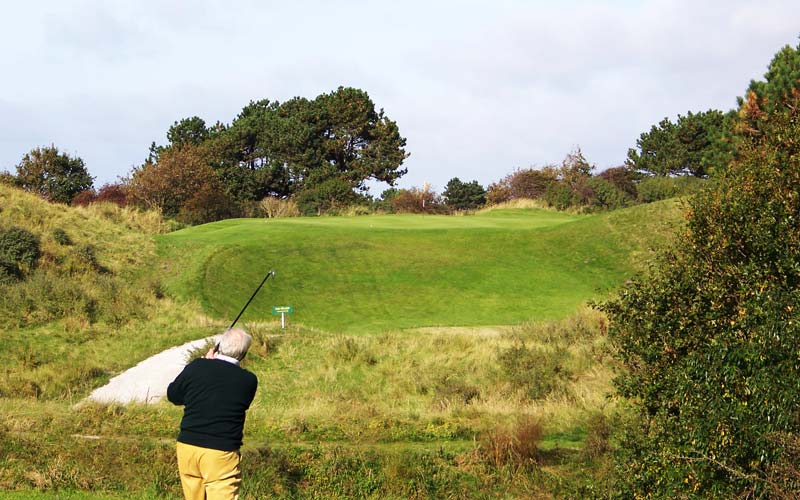
No architect has ever been better at finding natural green sites for par three holes than Harry Colt; the defenses of the bunkerless second green are evident. Though it looks terrfiying from the tee, the green is quite large and there is some room around it. Alister Mackenzie advocated holes that played easier than they looked and no doubt he would have greatly admired this hole.
Third hole, 530 yards; Originally, Colt had this as a par four to a green approximately eighty yards short of today’s. Pennink moved the green back in the mid-1980s, placing it on top of a ridge line. As seen with his work at the eighth and eleventh at Royal St. George’s and again here, Pennink had the curious ability to a) change holes from one par to another and b) have the newly created holes fit with their surrounding holes. In 2006, Colt expert Frank Pont was brought in to make the third green blend in better with the other Colt green sites. Trees were replaced by a bunker in the left front of the green. In addition, Pont created a deep grassy hollow behind the right of the green, similar for instance to the one behind Colt’s eighth green. All in all, the visitor is surprised to learn that today’s present green site isn’t Colt’s, a compliment to all those that have had a hand in the hole’s evolution.
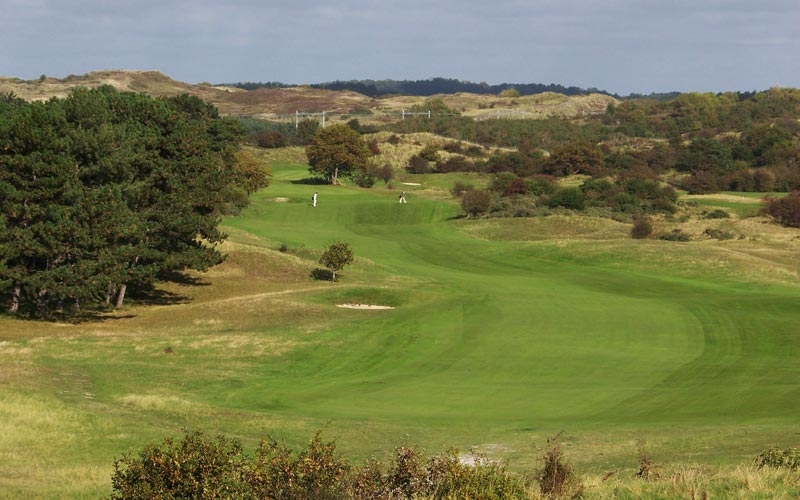
The golfer soaks up the view of the Dutch countryside from the elevated third tee. Despite being 1.5 kilometers from the North Sea, Kennemer is a links, thanks to the Netherland’s much broader dunesland than that in the United Kingdom.

Colt’s green was once in the foreground of this photograph. Pennink positioned it well back on top of landform, thus creating a second par five to the front nine. Frank Pont’s recent work to the green surrounds makes it fit in well with the rest of Colt’s holes.
Fifth hole, 345 yards; Doglegging rightalong the perimeter of the property by the rail line, there is no reason for the hole to be as good as it is as Colt didn’t have much with which to work. However, a bunker shortleft of the green just where a big drive might finish coupled with its green that angles away behind a depression and one finds a very good hole of modest length.
Seventh hole, 370 yards; From the day play commenced at Kennmer in 1928, this has been one of Europe’s most respected holes. In its first several years, it was particularly fearsome as golf was still played with hickory shaft clubs. After three holes in the only calm portion of the property, the blind tee ball here signifies a return into the Kennemer’s famed dunescape. Colt put a ridgeline to maximum effect when he cutfour deep bunkers into its face and then placed the green fifteen paces behind it. Overtime, three of those four bunker were consolidated into one long one. However, keen to remain true to its Colt roots, the club is working with Frank Pont to return the bunkers to how they were in Colt’s day.
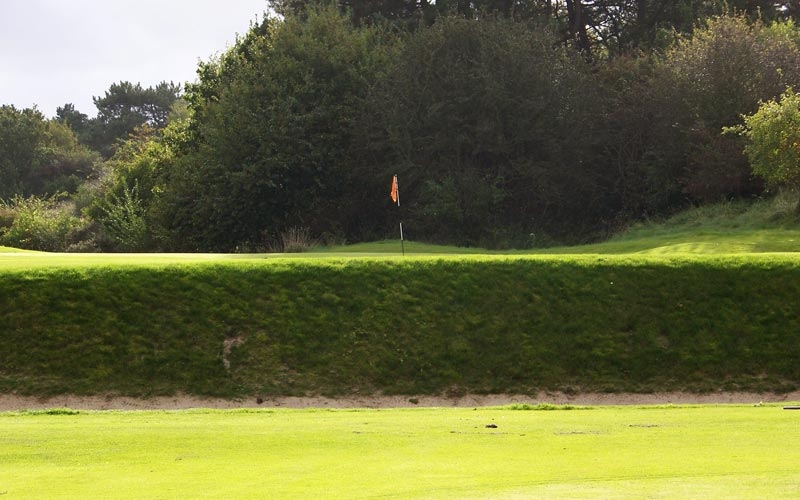
Access to the seventh green is walled off by a six foot deep bunker that nearly stretches across the entire fairway. Unusual for Colt not to give the golfer an alternate route, …

…he nonetheless gave the golfer room past the hazard to land his ball and have it run onto the green. This was important as the seventh frequently plays into the wind, requiring some sort of low punch shot.
Ninth hole, 425 yards; Once while playing the Composite Course at Royal Melbourne, Tom Watson walked past the sixteenth hole on the East Course which was not in play and remarked something along the lines, ‘That’s the finest hole I’ve never played.’ That sentiment applies equally well here as this sterling links hole which isn’t used as one of the eighteen holes for the Dutch Open. Regardless, one can imagine Colt’s joy as he was routing the course at finding a high spot in the corner of the property. Seizing upon it as the ideal place for a tee, Colt then ran the rest of the hole back toward the clubhouse. Its fairway is a marvel, complete with the kind of two to four foot ripples and swales that are nearly impossible for man to create and that yet lend so much golfing interest to any hole.
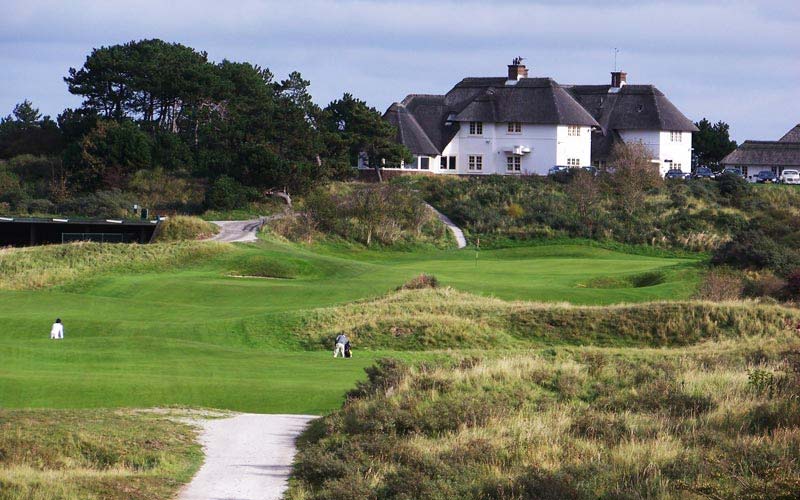
From an elevated tee atop a dune in the corner of the property, the golfer plays toward the clubhouse. Note the folds in the ground relative to the height of the golfers.
Tenth hole, 355 yards; The tenth green and flag are readily visible from the dune top upon which Colt placed the tee.Unfortunately, the fairway would not be within a straight line drawn from tee to green,as Colt swung it out to the left.For decades, golfers have had to make themselves aim away from the flag, never an easy task. Far too often, golfers are lured from the tee in the general direction of the green, leaving them an approach shot from a far worse angle than if they had resisted and played the hole out to the left.
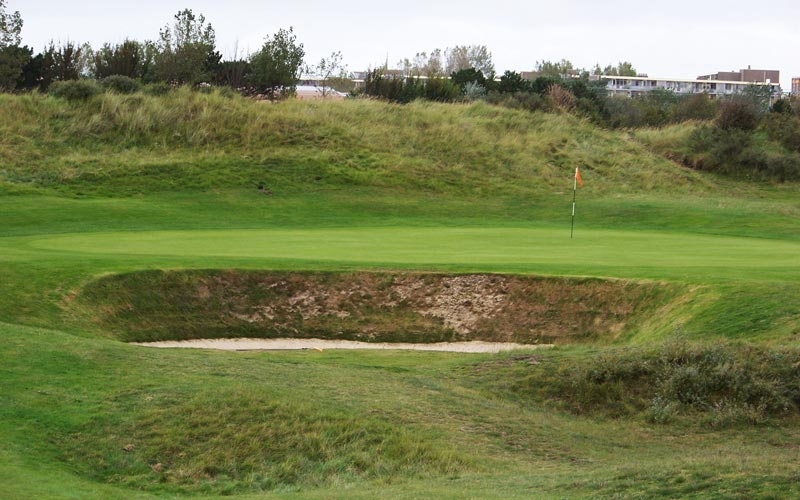
A tee ball played directly at the tenth green leaves an awkward pitch directly over the front bunker. Fortunately, the backstop behind the green helps access back hole locations.
continued >>>
Kennemer Golf & Country Club
Zandvoort, Netherlands
Twelfth hole, 550 yards; Kennemer is another example of Colt creating a loop within a loop. As seen at Muirfield, and again here, the B nine runs in a counterclockwise loop with the fourth through the ninth holes running along the perimeter of the property. The C nine plays within this broad loop and the long three shot twelfth takes the golfer to this nine’s farthest point from the clubhouse. As it generally plays downwind, the key on this straight hole is to keep the ball in play off the tee as hopefully the green may then be in reach. Landing one’s long approach just past the bunker forty yards short of the green and watching it climb onto the green is a shot one never tires of playing.
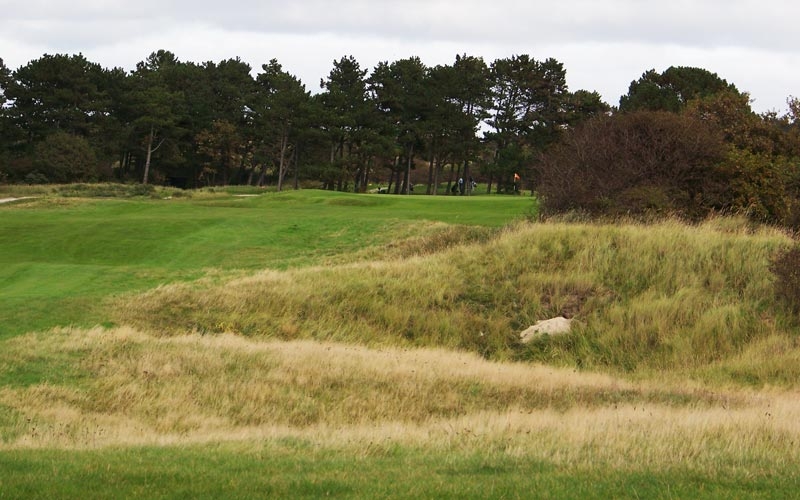
Visually, Kennemer has great texture and the golfer is well served not to stray to the right as he plays down the long twelfth as he inadvertently will find himself back in the dunes.
Fourteenth hole, 385 yards; Golf was a forgotten sport from 1940 through 1945. Best case, courses lay fallow during World War II but more often like here, numerous features were obliterated. Bunkers can be readily identified and re-built but recapturing some of Colt’s magic within the greens themselves can be more elusive. One of the best greens on the property comes here, thanks to its back to front tilt and subtle rolls throughout.
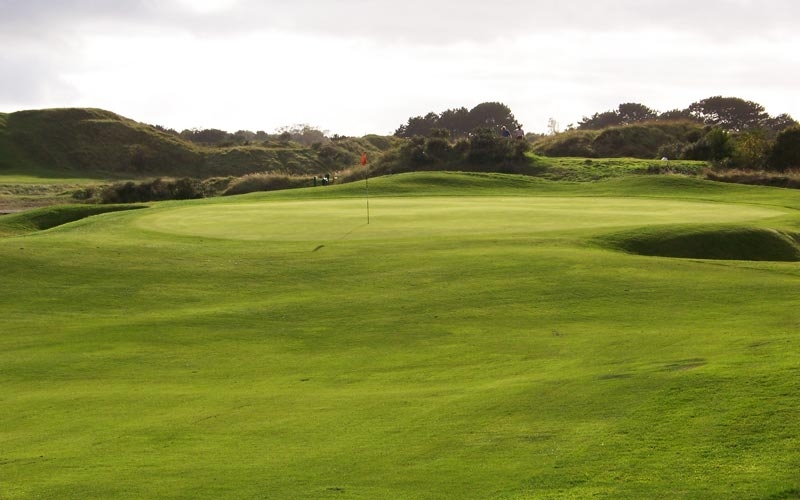
Some of the subleties of the fourteenth green are captured in the photograph above.
Fifteenth hole, 165 yards; This is one of the first holes that Colt found when he routed the course and he talked about it in glowing terms two years before the course even opened. Unlike some architects who talk a lot but deliver little, Colt made good on his promise.
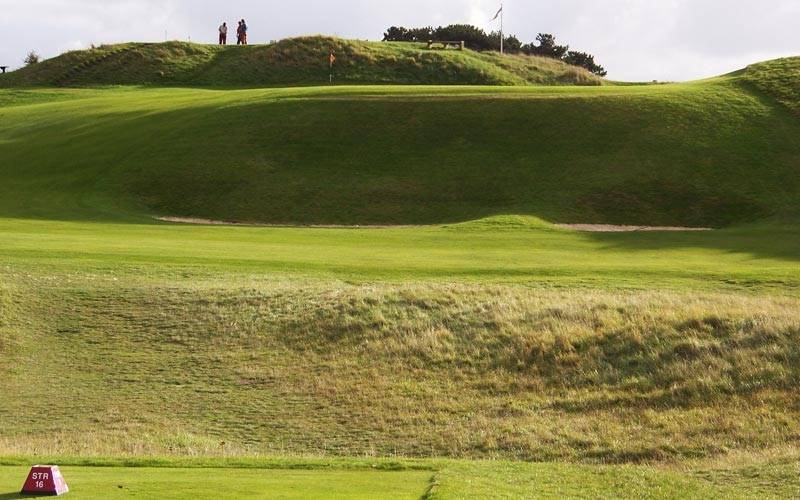
The daunting prospect from the fifteenth tee. Tee balls short and left roll back fifty (!) yards.
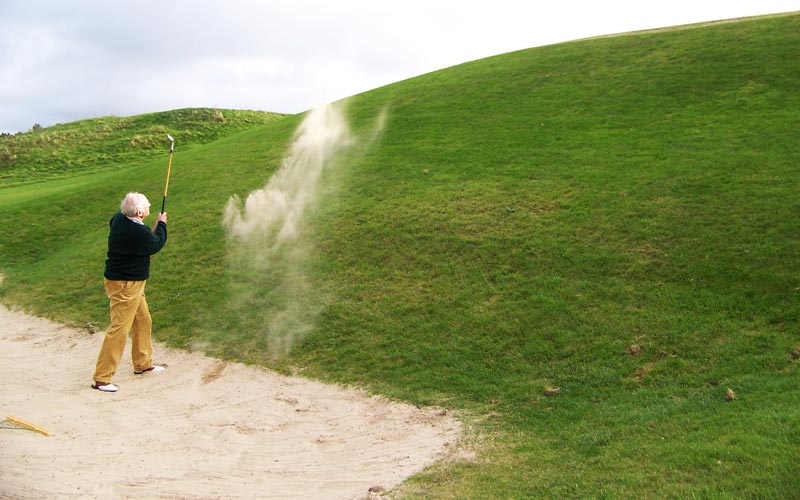
Club historian Dolph Cox niftely recovers from the the left front bunker with a niblick.
Sixteenth hole, 485 yards; Sadly, the notion of par influences how some people view a hole. With the sixteenth tee near the high spot on the course, it plays shorter than its yardage suggests. Furthermore, it frequently plays down a crossing wind and on such days, some of Europe’s best hit the green in two with a short iron. Consequently, the hole gets termed a weak par five. What nonsense! Call it a par four if you must, but just appreciate it for what it is: a thrilling hole.
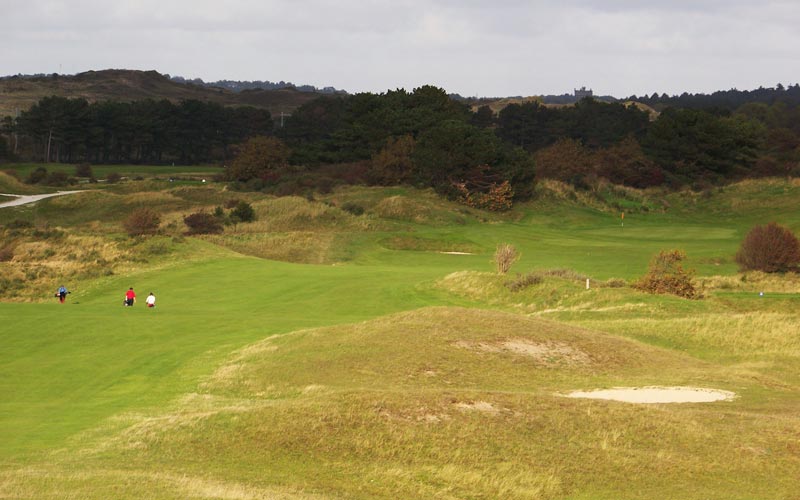
The long sixteenth works its way through the dunes.

Starting 185 yards from the green, this ridge line angles into the fairway from the right. Approaches played from that side of the fairway are frequently blind because of it, making this a neat hazard in its own right.
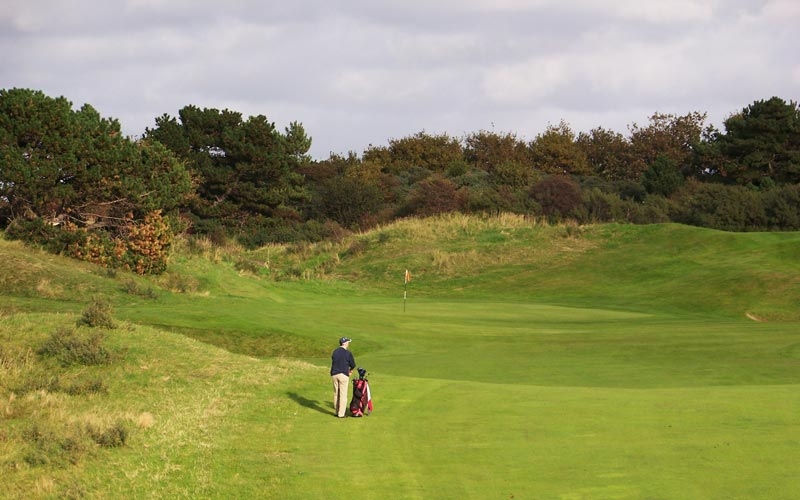
An approach from the left of the sixteenth fairway provides a better view of the green, which lays peacefully upon the ground at the base of the dunes.
Eighteenth hole, 400 yards; How to lend straight holes playing interest is always a tricky proposition. If all that is required is two straight shots, then the player may as well be on the range. In the case of the eighteenth, which is uphill and frequently into the wind, Colt gave the hole its playing interest by creating the deepest greenside bunker front left. Thus, the challenge is always to drive up the right of the fairway, avoiding the two bunkers cut into the right hillside.

A view past the seventeenth green and up the eighteenth fairway. The golfer about to hit his approach to the Home green enjoys a far better angle than did his playing partner to the left.
A4 , 400 yards; One of the benefits to building on sandy soil is the range in green sites that the architect is afforded. Of course, it is up to the architect to take advantage of that luxury when the opportunity presents itself. A text book example is how Colt starts off his B nine with a green down in a dell and followed by one high on a plateau. Again here, thanks to the sandy soil providing a way for water to escape, Pennink adhered to Colt’s routing and placed the green low, behind the shoulder of a dune. In so doing, he gave this modest length hole its character.
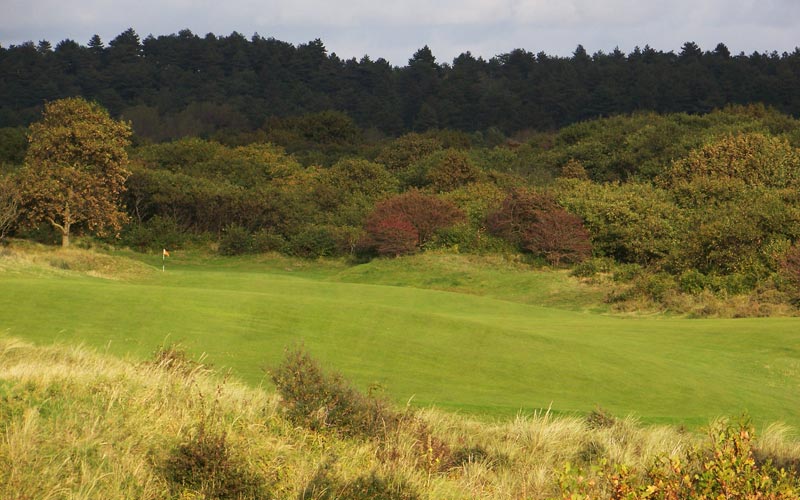
As seen from the tee, the use of the landforms give the fourth hole a links feel while the vegetation and trees tell the golfer that he is inland.
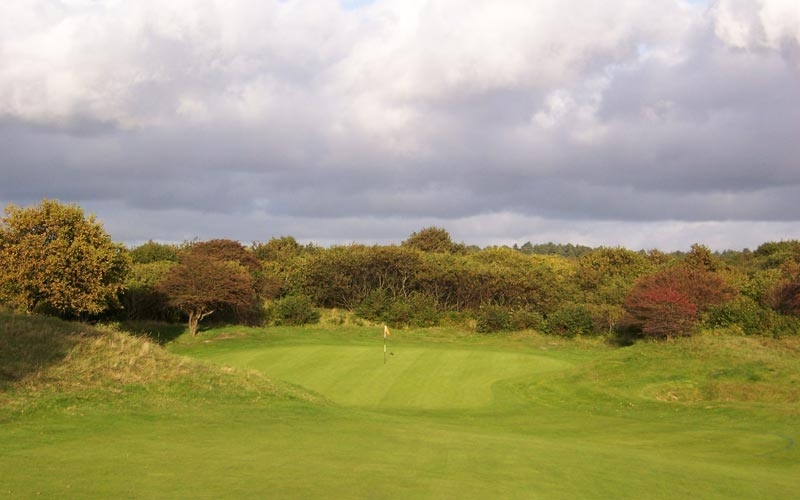
The fourth green is well placed, partially tucked behind a dune.
A5, 420 yards; Kennemer deserves credit in recent years for clearing brush and trees that had encroached into the playing corridors. Indeed, some of the European Tour players were critical of the A nine in days gone by because they felt that the proximity of the brush to the fairway was too penal. There was never any recovery shot options for wayward tee balls and balls could be readily lost. Fortunately, the club appreciated that defensive golf through tightly defined playing corridors is rarely interesting. Intelligent brush and tree clearing continues to this day, exposing the great attribute of the A nine, namely how Colt’s routing took advantage of the rolling topography.
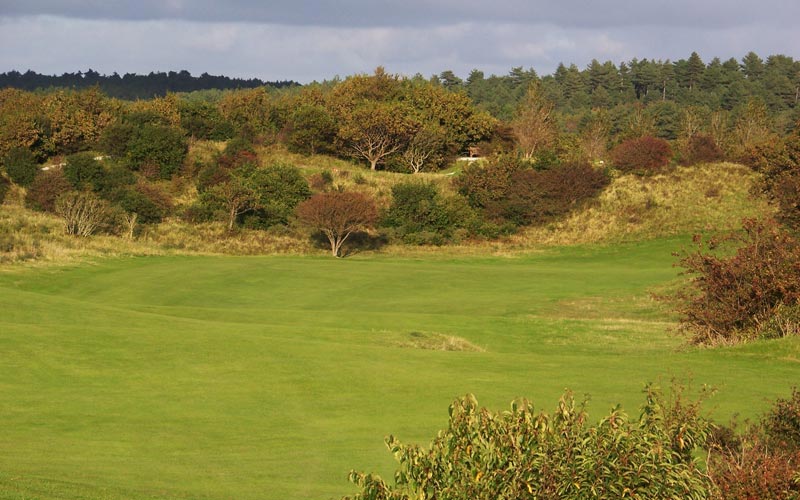
The view from the fifth tee shows the broad fairway as it sweeps to the right. The joy of this natural golf terrain was once snuffed out by allowing brush and trees to crowd in the golf.
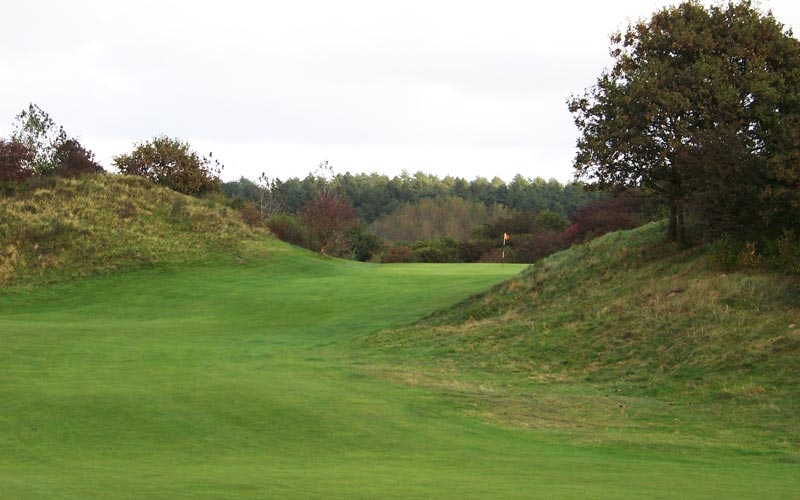
The approach to the fifth is played over the shoulder of a dune.
A9, 420 yards; Pennink was economical with his use of bunkers. With great sites, such as here and Noordwijkse, he let the land speak for itself and didn’t clutter it up needlessly with man-made bunkers. Three of the finest holes on this nine – the fifth, the long, twisting three shot seventh, and here at the ninth – are bunkerless and are all the better for it.
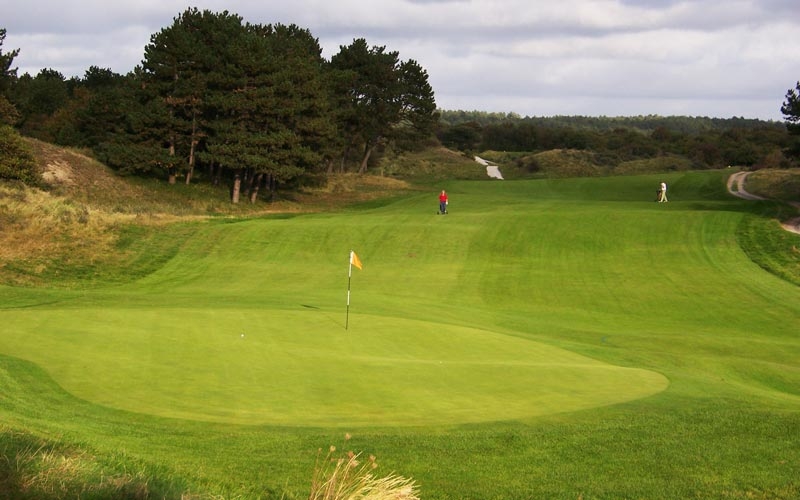
As seen from behind, the ninth hole is made by the angle in which its green was benched into the hillside.
Frank Pont perfectly sums up Colt’s work at Kennemer when he writes,
‘The Kennemer, and especially the B+C combination of holes, is the most classic links course in the Netherlands. The variety of holes is excellent, the routing feels very natural and isn’t to heavy on the legs and the detailing of the green surrounds is superb. Would the course be situated on Long Island or on the coast of Kent rather than west of Amsterdam I’m pretty sure it would be in everybody’s top five list of Colt courses.Visitors have told me that if they had one more round to play it would be Royal Hague, but it would be Kennemer where they would want to play their daily golf. That is the Kennemer, a course that will never bore you, rarely humiliate you but for sure will keep surprising you. Make that next trip to the links land of Holland rather than Scotland or Ireland; you will be most definitely surprised!’
After completing Kennemer, Colt was commissioned to build the classy De Pan, a little over an hour’s drive inland. His legacy in this relatively small country quickly built from there. Much like Alister Mackenzie in Australia and Charles Alison in Japan, he left an indelible stamp of high quality golf that still to this day defines the best that the country has to offer.
The End



